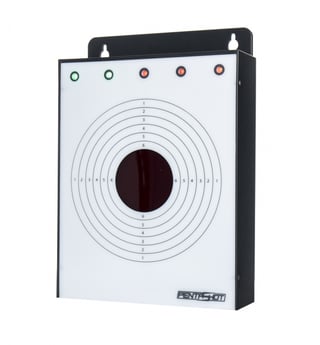I'm planning to build a laser shooting target. Something like this:
In the long term I want to build something advanced like a professional grade target, in which the user is able to tell exactly where was the shot, but for now I'd be happy with a basic one like in the image.
Basically whenever a laser shot hits the black area it counts as a shot inside. I'm just unsure about how can I do it since I don't want it to easily confuse a shot with regular light, and if possible I would like to use optics side-effects to avoid cross-shooting (whenever one shoots someone else target, while misaligned with it).
To begin with, one has to be 10 meters away from the laser target, with a variation of a meter at most. The targets are held at a meter and a half high. The laser of a gun, in conformance with the regulations, has a ~3 mW peak during 15-20 ms of activity. The black area is about 7 cm in diameter.
I don't know the official specifications for a laser target in terms of light, but I found a brand with the specifications of one target (end of the page). It states "Sun resistance: 70k Lux." Does that mean that it is able to distinguish a laser shot from the ambient light at up to 70k lux ambient light? What is a simple way to understand the amount of light that represents?
My idea so far its having a photo sensitive transistor in a PCB bolted to the back of the target. An aluminium sheet in the front with a circle in the middle of it, and a smoked acrylic sheet in its back (to fill the circle). And either a fresnel or a biconvex lens right next to the acrylic.
Both the biconvex lens and the acrylic converge the frontal light to a point (the point where the photo transistor stays), so that spot becomes mostly light coming exactly from the front of the target, and becomes sort of immune to most ambient light (since it will refract to the points around the transistor).
The problems I see so far are:
- Which one (fresnel/biconvex) has the shortest light converging point?
(I would prefer the target as slim as possible) - If one shoots the edge of the valid area, it's not a straight shot. Assuming one is perfectly aligned with the target, and the weapon is at its height, it would already become a ~90.2° incision. Being a little misaligned (half meter) and being half a meter lower than the target while shooting the center would represent a ~90.4° incision. Being misaligned and shooting the edge opposed to the misalignment direction would be an even more tilted shot. Is that little tilt enough to make the lens focus out of the transistor? It seems like a really small deviation.
- Is it worth it to get a sheet of red cellophane between the acrylic and the transistor? It would filter the non-red light, wouldn't it?
- To avoid counting lights turning on or a cloud passing by as valid shots, can I can count 30 ms from the moment in which the light peak happens, and see if it has disappeared?
So basically the main question is:
Would either of these two lenses solve my problem, by converging the light coming from one direction into one point? Would it be practical? Are there better alternatives (like leaving the transistor alone without focusing; mirrors; etc.)?
EDIT:
Floris guess was probably right. The signal seems to be modulated. I managed to have a shot at the spec sheet of one of the guns: Those graphs mean that with UIPM 2014 signal it pulses 10 times in 15.6 milisecs?
Should I get my target also recognising those pulses?
I bought a BH1750FVI light sensor module, can those kind of sensors recognise differences of light in fractions of miliseconds?
EDIT2:
Found the official regulations:
Those graphs mean that with UIPM 2014 signal it pulses 10 times in 15.6 milisecs?
Should I get my target also recognising those pulses?
I bought a BH1750FVI light sensor module, can those kind of sensors recognise differences of light in fractions of miliseconds?
EDIT2:
Found the official regulations:




Together with what was already answered, it should be enough to help anyone with the same question.



